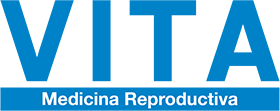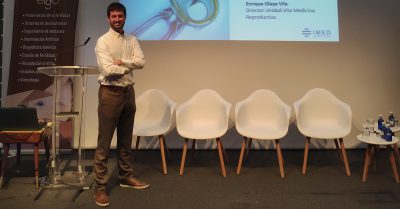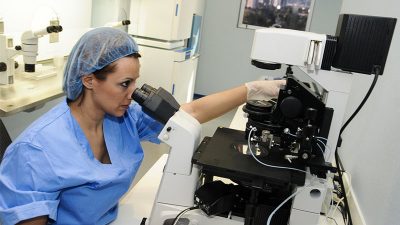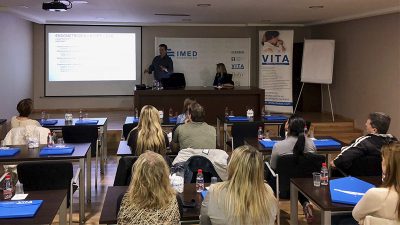Egg donation with the partner’s sperm

Egg donation with the partner’s sperm is a technique whereby a young and healthy woman decides to donate her eggs – anonymously and altruistically – to assisted reproduction centers so that they can be used by other women or couples who have pregnancy female fertility problems. These donated eggs are fertilized by the partner’s sperm in the laboratory. Those that are correctly fertilized are monitored for several days until the best quality embryos are transferred to the maternal uterus. It is the most effective assisted reproduction technique, due to its high pregnancy rates.
What does the egg donation with the partner’s sperm consist of?
In egg donation, a healthy young woman decides to donate her oocytes to assisted reproduction centers so that they can be used by other women or couples who have female fertility problems. The donor is selected through a rigorous screening that evaluates her psychological, physical, gynecological and fertility state, in addition to performing a genetic analysis to detect sexually transmitted diseases.
This egg donor must be between 18 and 35 years old, in perfect health, have a family medical history that guarantees that they will not transmit genetic or hereditary diseases or congenital malformations and can only be donor for a total of 6 living babies, counting donations and their own children.
Once all the studies have been carried out on the donor and it has been verified that she is suitable for donation, the search begins for a recipient who is phenotypically and immunologically similar.
To synchronize the menstrual cycles of both women, the donor will start taking an anovulant that will be withdrawn before starting the ovarian stimulation.
Once the oocytes are obtained, the partner’s sperm will be prepared. This process is known as sperm capacitation.
The partner’s semen sample is selected in the laboratory using washing techniques, where the sperm with the highest mobility will be chosen.
Simultaneously to ovarian stimulation and follicular puncture in the egg donor, the egg recipient will undergo endometrial preparation treatment in order to receive the embryos.
For this purpose, an injection of a GnRH analogue will be given on day 22 of the menstrual cycle to desensitise the pituitary gland. As soon as menstruation stops, oestrogen treatment will be started, at increasing doses, to achieve adequate endometrial thickness, which will be assessed by vaginal ultrasound. Once the endometrium has grown, the embryo transfer can be performed.
On the day of the donor’s follicular puncture, the oocytes will be retrieved and inseminated with the semen of the recipient’s partner.
Depending on the characteristics of the semen sample used and on the patient’s history, insemination will be performed using conventional IVF and/or ICSI.
Through conventional IVF, the oocytes retrieved from the donor and the fit spermatozoa of the recipient woman’s partner are brought into contact in a laboratory dish, and one of them is expected to fertilize the oocyte autonomously.
Through ICSI (intracytoplasmic sperm injection), the embryologist introduces a sperm selected from the semen sample of the recipient woman’s partner into each oocyte with the help of a micromanipulator and a microneedle, directly in the laboratory.
The day after the insemination, the fertilization of the oocytes is monitored.
The embryos that have been fertilized correctly will be kept in the laboratory under observation for several days (between 2 and 5 days). Day by day the division of the embryos into an increasing number of cells will be monitored.
The embryos with the appropriate morphological characteristics will be the ones transferred to the uterus of the recipient woman, and if there are spare they will be frozen.
The appropriate number of embryos to be transferred will be decided on the day of the transfer, the maximum being three per cycle.
The gynecologist will use a small catheter to guide the embryos through the cervix and into the uterus. The embryo transfer procedure lasts a few minutes and the patient recovery time is minimal.
The pregnancy test will be carried out by means of a blood or urine test 14 days after the insemination. If the patient suffers from bleeding before the test, it is important that she never stops taking the medication and that she seeks advice from the medical team.
Throughout the artificial insemination treatment, her personal assistant will be available at all times to answer any questions she may have and support her in this very special moment.
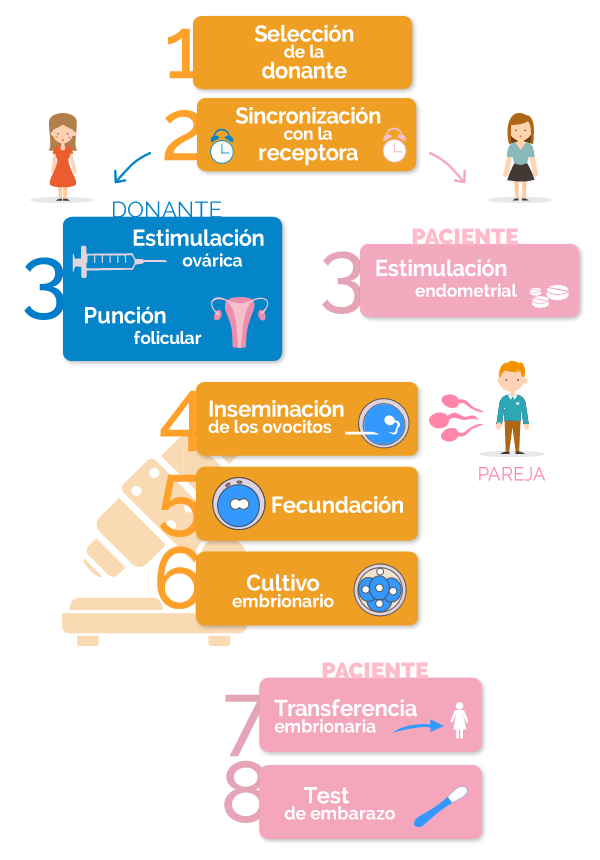
For whom is this technique indicated?
Egg donation with the partner’s semen is indicated for
- Couples where the woman suffers from ovarian failure due to menopause, premature ovarian failure or ovarian surgery.
- Couples where the woman is elderly.
- Couples where the woman cannot use her own oocytes because of their poor quality.
- Couples where the woman has experienced repeated implantation failures in In Vitro Fertilisation treatments.
- Couples where the woman has undergone surgery, chemotherapy and radiotherapy treatments.
- Couples where the woman has chromosomal alterations and serious hereditary diseases that cannot be detected by PGD techniques.
- Couples who have suffered recurrent miscarriages.
- Couples who have failed other previous assisted reproduction techniques.
At VITA we have a team of specialists in charge of carrying out the selection process of oocyte donors and their subsequent coordination with the recipient patients.
The donation of oocytes in Spain is altruistic, anonymous and completely legal.
Where do egg donors come from?
According to the Spanish legislation on donations, egg donors must meet some requirements. They must be between the ages of 18 and 35, in good mental and physical health, and free of any genetic or sexually transmitted disease.
The donors are young women who freely decide to carry out an altruistic and anonymous act of solidarity to help other women fulfill their dream of becoming mothers. All donors go through a “Donor Screening“, a rigorous medical and psychological examination to guarantee the highest quality and safety in the treatments.
Donors undergo a complete medical check-up where diseases, family history and personal habits are evaluated. A psychological test, a gynecological examination, an ultrasound scan and blood tests are carried out, as well as a genetic study of autosomal recessive diseases carriers.
If all the tests are satisfactory, the donor is included in our donor database until there is a possible recipient compatible with her phenotype (physical characteristics).

